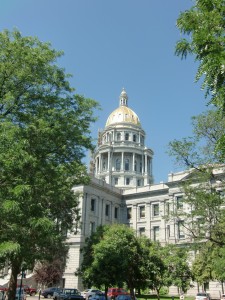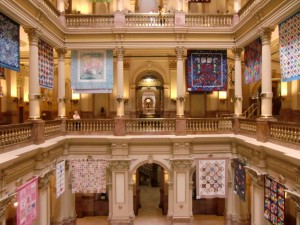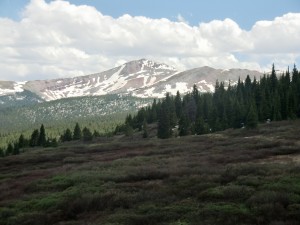THE BEST OF THE WEST – FROM ONE CAPITAL TO ANOTHER
THE BEST OF THE WEST
This is the tenth in a series of articles about traveling the west by bus
FROM ONE CAPITAL TO ANOTHER
By Charles N. Stevens
Photos by Dolores Seidman
Leaving Wyoming’s capital on a clear morning, we head for Colorado’s capital, Denver. A bank of clouds lies to the west, partially obscuring the snow-capped Rocky Mountains. As we leave town, we catch one last glimpse of Wyoming’s golden capitol dome.
We soon cross over the Colorado border, the landscape rolling hills covered with green grasses, the kind of country in which prong-horn antelope feel at home. Three of them graze near the highway, oblivious to the cars. As we travel south the grasses become shorter and browner then are replaced by farms raising hay, corn, alfalfa and cattle. At Ft. Collins we pass a huge Budweiser Brewery. How many are there in the West? Cottonwoods, heavy with fluff, release it to the wind and Russian Olives, their leaves turned over in the same wind show white to silver. An extensive field of barley, grown specifically for Coors beer (so the sign says) thrives not far from where corn “as high as an elephant’s eye” reaches for the sky.
Finally we see the skyline of Denver, its cluster of skyscrapers reminding me of the Emerald City in “The Wizard of Oz.” Soon we are among those towering buildings, our bus coming to a stop in front of the Capitol Building with its gleaming gold dome. Its interior of wood, marble and dazzling brass was almost too ornate. I wondered who polished all that brass! The chairs in the senate and representative chambers are covered in plastic, as the legislature is not in session. They meet on only 120 days out of the year.
Breezing around town by bus, we pass the home of the unsinkable Molly Brown, a famous survivor of the 1912 sinking of the Titanic. Cement lions guard her porch near large vases of flowers. Our bus rolls by many fine homes in the Capital Hill area, most of them dating from the 20s. We zip by Denver’s huge library and then the art museum housed in a structure resembling a gigantic origami bird. Looping around town we drive by the Denver Mint, the modern Wells Fargo Center, over fifty stories high, and the famous 1892 Brown Palace Hotel, tall and thin as it is squeezed into a triangular lot. We’re impressed with the soaring glass buildings and the amount of active cranes at work constructing more of them, the sign of a vital, growing city. A new trolley system winds through its streets making travel easier for everyone. Of course we have to see Mile High Stadium where the Denver Broncos play and Coors Field, the home of the Denver Rockies baseball team.
As it’s lunchtime, we stop at the modern Cherry Creek shopping Center, much of it reminding me of South Coast Plaza in Orange County. Dolores and I split a sumptuous dish at the Panda Express in their food court.
After lunch we make our way out of Denver and on to Interstate 70 and the Rocky Mountains. We’re soon cruising up through the green foothills of the Rockies. We begin to see the first pine trees as well as large homes built on the slopes affording a panorama of Denver. Forests of pine and fir increase, higher peaks around us still clinging to snow. We pass rugged rocky cliffs and the remains of old mines. We roll through Downieville and Silver Plume and forests of thin lodge pole pines. Entering the long Eisenhower Tunnel is quite an experience, the double-laned bore being over one and a half miles long. Built in 1973, it is the longest tunnel and the highest point (over 11,000 feet) on the Interstate Highway System. It passes directly over the Continental Divide. After the tunnel we begin to descend on the western side of the Rockies.
Snow is still on the ridges, a gorgeous view, and ski resorts and ski lifts abound. At a brief stop we step out into a cool wind blowing from the snowfields. As we continue down I-70 we come across the exclusive resort of Vail, Colorado with its fine homes, condos, golf courses and abundant ski slopes, ones that they have carved out of the forests. Our bus glides down through Glenwood Canyon among magnificent rocky cliffs, the Colorado River always at our side. The mountains become more desert-like with more space between Pinion pines and junipers.
By the time we reach Glenwood Springs at the base of Glenwood Canyon the temperature has risen to 92 degrees, quite a contrast to the cool winds we enjoyed at higher altitude. The famous Hotel Colorado, opened in 1893, sprawls over one side of the river, its patrons enjoying the pools from natural springs. Both Theodore Roosevelt and William Howard Taft spent extended stays there, giving it the title “little White House of the West.” Doc Holliday died in Glenwood Springs in 1887.
As we move on, the landscape becomes one of undulating hills covered with brown grasses and occasional stands of juniper. In places, the swollen Colorado River has overrun its banks, flowing out among the trees and shrubs, sometimes coming close to the highway and the Union Pacific tracks. In a narrower canyon where the river becomes turbulent, a number of kayakers hone their skills, challenging the rapids.
Just outside Grand Junction, Colorado is the town of Fruita; an area blessed with a microclimate allowing them to successfully plant fruit orchards as well vineyards. We finally arrive in Grand Junction, a much larger town than I thought it would be. After a sumptuous buffet at the Golden Corral, the combination of a very long day and the sedative of a large meal send us early to bed.

Denver is proud of its gold domed capitol building.

Inside the ornate capitol building local quilts were on display.

After leaving Denver we climb into the Rockies, still draped with snow.

Traveling out of the Rockies, we pass the magnificent rocky cliffs of Glen Canyon
MONTEREY PARK AUTHOR PUBLISHES 3RD BOOK ABOUT HIS EXPERIENCES IN WORLD WAR II- BACK FROM COMBAT
Charles “Norm” Stevens, a 40 year resident of Monterey Park and World War II Veteran has recently published the 3rd in his series about his experiences in WW II, Back from Combat: A WWII Bombardier Faces His Military Future. This book details the time from when he returned from combat in England where he flew 34 missions over Germany and France until the end of the war. Faced with large numbers of returning combat vets, and not knowing how long the war would continue, the military had to plan for their future. His options were whether to return to combat, become an instructor in the U.S., or receive new training that he would use in the Pacific. The book concludes with the end of the war with an Afterward that includes an update on the B-l7’s still flying in the U.S., as well as present day accounts pertaining to the war.
Stevens is the author of two previous books about his experiences:
An Innocent at Polebrook: A Memoir of an 8th Air Force Bombardier (Story of his 34 bombing missions from his base at Polebrook, England over Germany and France)
The Innocent Cadet: Becoming A World War II Bombardier (A prequel to the first, telling of his training in the U.S. before going overseas into combat.)
He is known to the readers of The Citizen’s Voice as the author of Travel Log Articles including “From Paris to Normandy on the Seine”, “Exploring New York” and “In Search of Snow.” He is retired, having taught for 32 years, primarily in the Montebello Unified School District.
Those interested in purchasing an autographed copy of any of his books, may contact the author at 323-721-8230 or Normstevens24@gmail.com.



